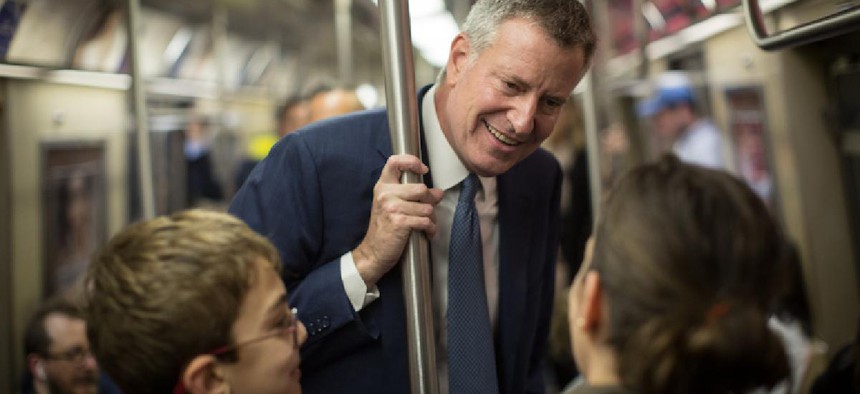As New York City Mayor Bill de Blasio prepares for his re-election bid, there are several issues that will likely occupy much of his attention in the upcoming months – affordable housing, homelessness, and how to solve the quandary that is Rikers Island. However, he would be remiss to ignore the growing transit crisis in his fair city. Although Gov. Andrew Cuomo controls much of the Metropolitan Transportation Authority – and the narrative blaming de Blasio for poor service, delays and line closures – the mayor still has the ability to choose transportation priorities that would help the most vulnerable New Yorkers and strengthen his case for re-election in the fall.
In 2013, de Blasio ran on a platform of social justice, but has failed to address the “Tale of Two Cities” through his transportation initiatives. Often, the mayor’s transportation priorities look more like a real estate development plan than a transportation justice agenda.
The mayor has advocated for a new streetcar, which would run along the Brooklyn-Queens waterfront. However, this $2.5 billion project is widely viewed as an initiative to appease real estate developers in a 21st-century version of “neighborhood prospecting.” He has expanded Citi Bike throughout the boroughs and more extensively in Manhattan. However, the average Citi Bike user makes more than $100,000 a year, and the data shows that most users primarily ride in Manhattan. Additionally, the city has not committed to contributing funds directly to expand the program more extensively throughout neighborhoods most in need of alternative transportation options.
De Blasio has also begun plans for a citywide ferry service that will serve waterfront neighborhoods. It appears the ferry will largely serve Brooklyn and Queens neighborhoods in desperate need of increased transportation options. However, some critics fear the cost of the program and the limited daily ridership expected may not be the most expeditious use of funds.
It is abundantly clear that the mayor is attempting a multipronged approach to transportation expansion, especially within the constraints of Albany and his relationship with Cuomo, the keeper of the purse. But the mayor’s proposed streetcar, Citi Bike expansion and ferry service, although innovative, still leave far too many lower-income New Yorkers without viable transportation options.
Some relatively straightforward initiatives could greatly increase the lives and livelihoods of some of the most vulnerable populations in the city. The Fair Fares proposal would introduce a half-price MetroCard for everyone living below the poverty line at a comparable cost to the city – an estimated $212 million annually – as the citywide ferries ($196 million) and significantly cheaper than the streetcar ($2.5 billion to build it out, plus $26 million annually to operate).
The mayor did not include the Fair Fares proposal in his $84.7 billion preliminary budget, arguing that the city cannot afford it and should look to Albany for the money since the governor controls the MTA. The governor does run the MTA, but the mayor could take the rare opportunity to one-up his political rival and take some ownership over New York City’s public transportation system by funding fair fares. And it’s smart politics – an estimated 800,000 low-income New Yorkers would benefit from a half-price MetroCard, more than the total number of voters (691,801) who cast ballots in the 2013 Democratic mayoral primary.
Additionally, most New Yorkers who are elderly and/or living at or below the poverty line rely on bus service. These individuals need de Blasio to be their greatest advocate. The mayor has initiated concrete improvements to certain bus service lines by expanding Select Bus Service, and that is a good start. But he could also tackle the problem of improving local bus service, starting with new bus lanes and bus stop countdown clocks and other rider-friendly initiatives that are within the mayor’s power to implement.
It is imperative that New Yorkers have a mayor who is a champion of innovative transportation options for all. Decreasing MetroCard fares for the poor and elderly, and improving bus service throughout all five boroughs, will greatly improve the lives of millions of city residents, not just a few thousand.
If de Blasio’s recent MTA board appointments of Veronica Vanterpool and David Jones are indications of his attempt to better understand the multifaceted transportation needs of the city, he is clearly looking in the right direction. Vanterpool is a longtime transit justice advocate and Jones is the head of Community Service Society of New York and a leading proponent in the Fair Fares campaign.
As the mayor negotiates with the City Council over budget priorities for the city, here’s hoping he will come to think of transportation not just as an opportunity for signature projects, but also as a way to pursue his social justice agenda for New York’s most vulnerable communities.
Dr. Christina Greer is an associate professor of political science at Fordham University.
NEXT STORY: Standing up for our veterans in Albany


